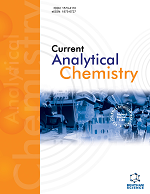- Home
- A-Z Publications
- Current Analytical Chemistry
- Previous Issues
- Volume 17, Issue 1, 2021
Current Analytical Chemistry - Volume 17, Issue 1, 2021
Volume 17, Issue 1, 2021
-
-
Application of Functionalized Nanomaterials as Effective Adsorbents for the Removal of Heavy Metals from Wastewater: A Review
More LessBackground: Nanomaterials offer promising remediation techniques for water containing toxic pollutants especially heavy metals. Methods: A complete analysis of the application of nano-adsorbents for heavy metals removal from water has been reviewed. The effect of their functionalization on the adsorption capacity, the reusability, and the surface area has also been discussed. Results: In particular, the foc Read More
-
-
-
Review of Recent Progress in Wastewater Treatment Using Carbon Nanotubes
More LessAuthors: Abrar Inayat, Zafar Said, Ola Alsaidi, Ruqaya Al-Zaidi, Sami Ullah and Vassilis StathopoulosBackground: Clean and clear water is an essential element in our life. Finding new and innovative approaches to purify water is a critical topic in research and development. Carbon nanotubes are promising adsorbent for many stable organic compounds. The ability of wastewater treatment using carbon nanotubes was studied in this review article. Methods: Adsorption mechanism was discussed based on several research stu Read More
-
-
-
Photocatalytic Inactivation of Bioaerosols: A Short Review on Emerging Technologies
More LessAuthors: Nadia Riaz, Muhammad S. Khan, Muhammad Bilal, Sami Ullah and Abdullah G. Al-SehemiBackground: Formation of the microbial colonies in the wet and damp environment affects the indoor air quality thus posing severe threats to human health. Health problems or Building- associated illness (any disease or infection) caused by being in a closed space or building are generally separated into two categories including building-related illness (BRI) and sick building syndrome (SBS). Considered by Pathognomy resea Read More
-
-
-
Nanoparticles and Significance of Photocatalytic Nanoparticles in Wastewater Treatment: A Review
More LessAuthors: Muhammad Sagir, Muhammad B. Tahir, Jehangir Akram, Muhammad S. Tahir and Usama WaheedBackground: In the present situation where there is a water shortage globally, nanoparticles can play a vital role in treating wastewater to make it usable for several processes. Industrial wastewater contains numerous heavy metals and associated wastes that enter our food chain by one means or other. This article provides a review of applications of nanoparticles in wastewater treatment and highlights the significance of Read More
-
-
-
Cadmium Contamination, Bioavailability, Uptake Mechanism and Remediation Strategies in Soil-Plant-Environment System: a Critical Review
More LessAuthors: Umair Riaz, Ambreen Aslam, Qamar uz Zaman, Sabiha Javeid, Rehman Gul, Shazia Iqbal, Sana Javid, Ghulam Murtaza and Moazzam JamilBackground: Cadmium contamination is becoming an important issue globally due to its high toxicity and carcinogenicity, leading to detrimental effects on both environmental and human health. This review paper discusses the different sources of cadmium, its toxic effects on the environment and human health, and the influence of different soil factors in changing the speciation and bioavailability of cadmium in so Read More
-
-
-
Synthesis and Stability of Metal-organic Frameworks (MOFs) Photocatalysts for the Removal of Persistent Organic Pollutants (POPs) from Wastewater
More LessBackground: The removal of persistent organic pollutants (POPs) from the contaminated water by employing photocatalytic adsorption is considered as one of the most emerging technologies due to its’ cost- and energy-effectiveness. It has attracted significant attention of global researchers to process the world's wastewater. Methods: Among different adsorbents, the metal-organic frameworks (MOFs) have dem Read More
-
-
-
Emerging Aspects of Photo-catalysts (TiO2 & ZnO) Doped Zeolites and Advanced Oxidation Processes for Degradation of Azo Dyes: A Review
More LessBackground: Azo dyes are recognized as non-decomposable and recalcitrant compounds and can be depleted into more dangerous secondary products in anaerobic environments. In the current scenario, different water treatment strategies, including adsorption, photocatalysis, and advanced oxidation processes based practices, are facing different limitations. Methods: A literature survey was accomplished by search Read More
-
-
-
Photocatalytic Bacteria Inactivation by TiO2-Ag based Photocatalysts and the Effect on Antibiotic Resistance Profile
More LessAuthors: Can B. Ozkal and Süreyya MericBackground: In the last decade, research in the field of contaminants of emerging concern proliferated while special interest was focused on antibiotic-resistant bacteria, antibiotic resistance genes as widespread pollutants. Advanced oxidation processes have gained an essential attraction in the field of antibiotics degradation and bacteria inactivation Methods: Photocatalysts in the form of sol-gel based TiO2-Ag-xerogel and Read More
-
-
-
Melia azedarach Activated Carbon and its novel TiO2 Nanocomposite for Chemisorption and Photodecoloration of Reactive Orange 16: Isotherm and Kinetic Modeling
More LessBackground: Bulk generated textile wastewater loaded with dyes is posing a stern threat to aquatic health, especially when dumped without prior treatment. Lignocellulosic waste based activated carbon (AC) and Titania (TiO2) suspension can constitute the emerging technological solution. Objectives: Best lignocellulosic precursor biomass, Melia azedarach (Darek sawdust - DSD), was selected for ortho-phosphoric acid impr Read More
-
Volumes & issues
-
Volume 21 (2025)
-
Volume 20 (2024)
-
Volume 19 (2023)
-
Volume 18 (2022)
-
Volume 17 (2021)
-
Volume 16 (2020)
-
Volume 15 (2019)
-
Volume 14 (2018)
-
Volume 13 (2017)
-
Volume 12 (2016)
-
Volume 11 (2015)
-
Volume 10 (2014)
-
Volume 9 (2013)
-
Volume 8 (2012)
-
Volume 7 (2011)
-
Volume 6 (2010)
-
Volume 5 (2009)
-
Volume 4 (2008)
-
Volume 3 (2007)
-
Volume 2 (2006)
-
Volume 1 (2005)
Most Read This Month
Article
content/journals/cac
Journal
10
5
false
en


